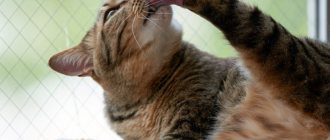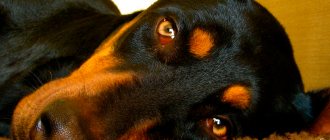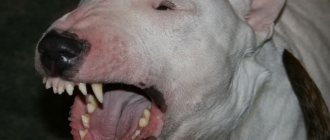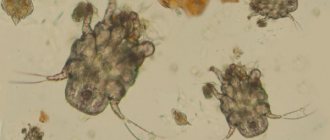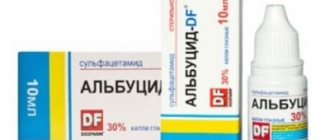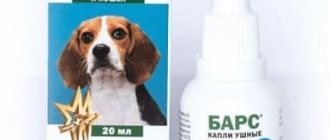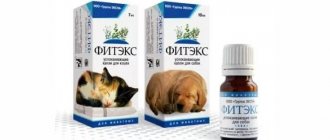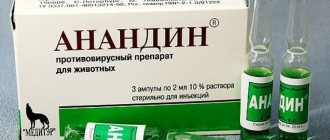Do I need to rinse?
The structure of a dog's ear canal differs from that of a human; veterinarians do not recommend using cotton swabs alone when cleaning the ear, since only a liquid product can remove dirt from hard-to-reach places.
Information! There are ear drops for dogs, intended for hygiene procedures, and medicinal, used as a medicine.
An experienced dog breeder knows that daily care of your dog's ears is essential. Such cleaning allows you to get rid of the occurrence of dangerous diseases and maintains the comfort of your pet.
In addition, regular ear hygiene helps to timely diagnose diseases in the early stages (redness of the ear, large amounts of wax, skin irritation, etc.).
In addition, if the dog previously tolerated the procedure calmly, then changes in behavior should alert the owner.
How to use ear drops correctly
To increase the effectiveness of treatment, it is important to follow several rules:
- Before you put drops in your dog's ears, you need to clean them thoroughly. To do this, you can use antiseptic ear drops, which are usually used for hygienic purposes. After this, softened dirt, scabs, etc. must be carefully removed using a cotton swab or pad.
- The required number of drops is applied to each ear. After this, you should close the ear canal with the free edges of drooping ears or bring the edges of the ears together if they are erect. And lightly massage the ears at the base so that the solution is better distributed over the inner surface.
- If the dog tries to shake its head after the procedure, it must be restrained from doing so for several minutes. Otherwise, she may shake the medicinal solution out of her ears.
- During the cold season, you should not take your dog out for a walk until the ears are dry.
These simple rules will help make the course of treatment more effective and speed up your pet’s recovery.
What to clean with?
Herbs
For daily procedures, use, for example, any herb that has antimicrobial properties (calendula), pour 50 ml of olive oil, leave for four days and instill 2-3 drops into the pet’s ears. To enhance the antimicrobial effect, add a clove of garlic to the resulting mixture.
Miramistin and chlorhexidine
For therapeutic procedures, antiseptics are used: miramistin or an aqueous solution of Chlorhexidine, which is used to treat the pet’s ear after removing pus and dirt (if there was any in the ears).
Important! The next step is to visit a veterinarian who will give your pet the correct diagnosis.
Instructions for use
How many drops should I use?
The dosage of Otipax for otitis is 4-5 drops in each ear, approximately every 8-9 hours, for 7-10 days.
How to give?
It should be noted that drops are instilled only into a clean ear, regardless of the disease. Putting drops into a dirty ear, no matter Otipax or another drug, is useless.
Moreover, this can be harmful, since the microflora quickly adapts to the medicine and begins to produce new resistant strains of bacteria. Don't punish your pet even more, do everything right from the very beginning.
Before instillation, hold the bottle of medicine in your hand so that the drops warm up a little, this way you can avoid frightening the animal and unnecessary resistance.
Reference. Some dog owners advise swaddling the animal first so that everything goes quickly and without complications. However, veterinarians consider these manipulations not rational, since the animal may regard these actions as a threat and behave extremely aggressively.
A dog is an animal that has always been distinguished by its special intelligence and intelligence, therefore, be patient and carefully begin preparing for the procedure. You must be calm and affectionate, then the tailed one will understand that you are not harming him, but want to help.
The animal and you should be comfortable; many prefer to carry out procedures on the floor, on the dog’s favorite rug. Prepare everything you need in advance (cotton swabs, cotton swabs, peroxide or boric alcohol, Otipax, etc.), without sudden movements, slowly instill ear drops.
If he resists
If the animal begins to make uncharacteristic sounds or struggle, you may be causing pain to the dog. You need to change tactics: take a break, offer your pet a treat, or start treating the other ear.
Remember, if the first procedure went without any “excesses,” then the subsequent ones will be simple and painless.
Which ones to choose?
Before you start treating your dog, you need to know that otitis media comes in different types and degrees of neglect. Depending on these indicators, the veterinarian recommends appropriate medications.
Otipax
- Indications for use : purulent otitis media. 4 drops 2-3 times a day, treatment period – 10 days.
- Description – ear drops with phenazone and lidocaine. Excipients: alcohol and glycerin.
- Advantages – effectively relieves pain, strong anesthetic.
- Disadvantages : Serious allergic reactions are possible. If your dog has a damaged eardrum, this product should not be used.
Anandin
- Indications for use : purulent otitis media. The dosage depends on the patient’s weight: from 3 drops for small dogs, to 5 drops for large dogs, 2 times a day. Treatment period is 3-4 days. Repeat after a week if necessary.
- Description – immunostimulant, has a wound healing effect, antibiotic.
- Advantages – eliminates the cause of the disease, symptoms. Safest for pets.
- Disadvantages – not used for dogs with a damaged eardrum.
Leopard
- Indications for use : parasitic otitis media. The dosage also depends on the weight. 3 drops for small animals, 5 drops for large animals. Treatment is carried out 2 times a day for 1 week.
- Description – antiparasitic drops, has antiseptic properties.
- Benefits – promotes tissue regeneration, heals wounds and scratches. Used as a means of disease prevention.
- Disadvantages - allergic reactions due to individual intolerance, prohibited for use in weakened, emaciated animals.
Otopedin
- Indications for use : traumatic otitis media. Treat once a week, 2-3 drops in each ear.
- Description – made on the basis of pine oil, has anti-inflammatory properties.
- Advantages – quickly copes with wound healing.
- Disadvantages are toxic. After treatment, fix the ears for 20 minutes.
Anauran
- Indications for use : allergic otitis media. Treatment is carried out 5 drops up to 3 times a day until complete healing.
- Description – broad spectrum antibiotic. Complex drug.
- Advantages – has an antibacterial effect.
- Disadvantages - contraindicated if the integrity of the eardrum is damaged.
Aurizon
- Indications for use : bacterial otitis media. 10 drops per day. The period of taking the drug is 7 days.
- Description – antifungal drug.
- Advantages – has a wide spectrum of action.
- Disadvantages - cannot be used on puppies, pregnant or lactating animals.
Types of major ear diseases
Ear diseases in dogs are a separate large group of pathologies. Without going into depth, they are classified based on the reason they occur:
- fungal;
- bacterial;
- allergic;
- parasitic. Here we are talking about ear scabies, which is caused by scabies mites - otodectosis, demodicosis, notoedrosis, sarcoptic mange;
- Separately, inflammatory ones can be distinguished, but it is worth understanding that almost any of the ear pathologies is accompanied by inflammation.
If you are told that your dog has an ear infection, it simply means that his ear is inflamed. It is necessary to clarify the diagnosis, stage and find out what led to the inflammation. Only then fight the disease.
The nature of the disease can only be determined in a clinical setting, after carrying out appropriate tests (at a minimum, they examine the ear canal using an otoscope, take a smear and examine it under a microscope).
Pregnant, lactating and puppies
Not only adult pets are susceptible to ear diseases, but also animals that need special care:
- puppies;
- feeding individuals;
- pregnant dogs.
For such categories of patients, special drugs are needed that do not have side effects.
Reference! For a special category of animals, medications must be safe to avoid negative effects on the body of young dogs, expectant mothers and babies.
No antibiotics
When treating otitis media, the harmless drug Otipax is used. Otipax is not an antibiotic, does not penetrate the body, acts at the local level (provided that the eardrum is not damaged), resistance and addiction do not develop, the medicine is not toxic, and is used even for newborn puppies.
Allergic reactions are possible due to individual intolerance to the drug. Before use, consult a veterinarian.
Otodepin
Veterinarians prescribe the hygienic ear drug “Otodepin” to animals for the effective treatment of external and internal otitis of various etiologies, as well as in the treatment of ulcers and hematomas. It is a light yellow transparent liquid of oily consistency with a pleasant pine odor. Packaged in sterile bottles of 10 ml. Otological veterinary medicine is also used for prophylactic purposes, to prevent the development of fungal and infectious diseases of the ears. Before use, the drops must be warmed to room temperature.
Otodepine contains pine essential oil, saponins, and mullein extract. The drug has a wound-healing, antimicrobial, antiseptic, deodorizing, and tonic effect. Eliminates inflammatory processes, improves metabolism in cellular structures, accelerates the healing of wounds and ulcers, and improves tissue trophism.
Otodepin for dogs
Otodepine does not have a sensitizing or toxic effect. Does not cause allergies. The drug is absolutely safe, low-toxic for dogs, regardless of their breed or age. It is acceptable to use for treatment and for preventive purposes in small puppies from three weeks of age. Side effects are noted in extremely rare cases and only in case of individual intolerance to the active components. Before use, carefully read the instructions for the veterinary drug.
Breed characteristics
There are animals at risk that have a hereditary tendency to the disease, since the disease is closely related to the structure of the auricle. These animals include:
- owners of long, floppy ears. The ears are hidden from natural ventilation, which causes the appearance and reproduction of pathogenic microorganisms (dachshunds, poodles, spaniels);
- animals with open ears. Such ears are not protected from the penetration of bacteria from outside (East European Shepherds).
For otitis media
Otitis in dogs is an inflammation of the ear in the inner or outer part (auditory canal). If your dog shakes, turns his head or constantly scratches his ears, then these are the first signs of illness.
If you feel an unpleasant odor, this is a reason to start sounding the alarm, because this disease can lead to negative consequences (perforation of the eardrum, tissue changes, hearing loss).
It is important to quickly make a correct diagnosis and prescribe a course of medications and procedures. There are many types of otitis (suppurative otitis media, allergic otitis, etc.), forms and complications, so it is impossible to make an accurate diagnosis at home.
Reference. Fold-eared and short breeds (dachshunds, basset dogs, cocker spaniels) are especially susceptible to otitis. Air does not flow well inside, which creates a warm and humid environment, and these are the best conditions for the proliferation of pathogenic bacteria. In addition, low-set ears practically drag along the ground, which significantly aggravates the situation and contributes to infection.
At the first symptoms of the inflammatory process, you can use Otipax drops; they will quickly relieve pain and inflammation. If the dog has an advanced form of otitis, then complex therapy is necessary; drops alone cannot do it.
Often, in combination with Otipax, rinsing with boric acid, hydrogen peroxide and antibiotics are prescribed. If otitis media is allergic in nature, then treatment includes taking antiallergic drugs and a hypoallergenic diet.
